Create modular code and interface with unfamiliar modularize
Create modular code and interface with unfamiliar modularized code The Task In this project you will be combining and building on what you have done in the first 2 projects. You are free to reuse any code that you wrote in the previous 2 projects or the provided Project 2 solution. This program should be a full calculator that uses the UART for both input and output. Calculator Operation You calculator should accept full mathematical expressions with 2 numbers and an operator (e.g. “1+2=”) and print the result to the UART using the provided module. It should handle the operators to add (+), subtract (-), and multiply (*), but it does not need to handle division. It should accept multiple expressions and generate the appropriate outputs for each expression without manually resetting the simulation (e.g. the input “51-4=6*2=” should output “47” followed by “12”). UART Module The UART Module is available on Blackboard as an ASM file. You can import it into a PLP project by navigating to “Project”, selecting “Import ASM file”, and then selecting the UART Module ASM file. The module contains a print function, project_3_output_number, which uses 2 registers as input arguments, $a0 and $a1. The register, $a0, is the value to be displayed on the UART and register $a1 is used to indicate the error message. If $a1 is non-zero an error message will be displayed regardless of the value in $a0. The table below indicates the mapping between $a1 and the UART output. $a0 $a1 UART Output Signed Number 0 Signed Decimal Number Any Value 1 “Error: Invalid character\ ” Any Value 2 “Error: Invalid expression\ ” Any Value 3 “Error: Input overflow\ ” Any Value 4 “Error: Output overflow\ ” Any Value 5 “Error: Unknown error code\ ” The only error your program needs to check for is invalid character ($a1 = 1), which is when a character is not a number character or one of the 3 operators (you can also allow space characters, but this is not required). If an invalid character is found the rest of the expression, up to the ‘=’ character, must still be read from the UART so that it does not affect the next expression. You may assume input follows the following format: \'=\' If at any point the contains something other than a character from \'0\' through \'9\' then the expression has an invalid character. In order to use the output function you PLP program needs to have initialized the stack pointer ($sp). You should typically initialize the stack pointer to 0x10fffffc (the last address of RAM). The output is called using the following instruction (the line following this instruction must be a valid PLP instruction otherwise you will most likely get an error during simulation): call project3_output_number After this function call, the value in $a0 (unless $a1 is set to something other than 0) will be displayed on the UART and then the program will return to the instruction immediately following the call instruction.
Solution
bcd_storage_p3:
.space 10 #creates 10 words here
invalid_char_p3:
.asciiz \"ERROR: Invalid character\ \"
invalid_expression_p3:
.asciiz \"ERROR: Invalid expression\ \"
input_overflow_p3:
.asciiz \"ERROR: Input overflow\ \"
output_overflow_p3:
.asciiz \"ERROR: Output overflow\ \"
unknown_error_p3:
.asciiz \"ERROR: Unknown error code\ \"
project3_output_number:
push $ra
# Check for error
beq $a1, $0, UART_no_error_p3
nop
addiu $t0, $0, 1
li $a0, invalid_char_p3
beq $a1, $t0, display_error_message_p3
nop
addiu $t0, $t0, 1
li $a0, invalid_expression_p3
beq $a1, $t0, display_error_message_p3
nop
addiu $t0, $t0, 1
li $a0, input_overflow_p3
beq $a1, $t0, display_error_message_p3
nop
addiu $t0, $t0, 1
li $a0, output_overflow_p3
beq $a1, $t0, display_error_message_p3
nop
li $a0, unknown_error_p3
display_error_message_p3:
jal libplp_uart_write_string_p3
nop
pop $ra
return
UART_no_error_p3:
#INITIALIZATIONS
# Saved Values
lui $s0, 0xF000 #UART
li $s1, 0x1 #mask for bit 0, used by put_char
li $s2, 0x2 #mask for bit 1, used by get_char
li $s3, 10 #used by decimal_to_binary
li $s4, 48 #subtract from ascii for decimal, used by decimal_to_binary
# Temporary Values
li $t0, 0 #counter in subroutines
li $t1, 0 #x: used for UART character reads and writes
# check if 0
bne $a0, $0, non-zero_input_p3
nop
addiu $t1, $0, \'0\' # set UART output value to \'0\'
jal put_char_p3
nop
addiu $t1, $0, 10 # set UART output value to \'\ \'
jal put_char_p3
nop
pop $ra
return
non-zero_input_p3:
# Get sign bit
move $t2, $a0
srl $t2, $t2, 31
beq $t2, $0, non_negative_output_p3
nop
jal handle_negative_p3
nop
non_negative_output_p3:
jal to_bcd_p3
nop
jal display_bcd_p3
nop
pop $ra
return
#=======================================FUNCTIONS=======================================
#Description: places number result ($s7) into the space at the label bcd_storage
#Resources: #uses $t0, t2, $t3, $t4
to_bcd_p3:
push $ra
li $s5, bcd_storage_p3
#set 10\'s place followed call subtract function to store bcd
li $s6, 1000000000 #10
jal base10_subtract
nop
li $s6, 100000000 #9
jal base10_subtract
nop
li $s6, 10000000 #8
jal base10_subtract
nop
li $s6, 1000000 #7
jal base10_subtract
nop
li $s6, 100000 #6
jal base10_subtract
nop
li $s6, 10000 #5
jal base10_subtract
nop
li $s6, 1000 #4
jal base10_subtract
nop
li $s6, 100 #3
jal base10_subtract
nop
li $s6, 10 #2
jal base10_subtract
nop
li $s6, 1 #1
jal base10_subtract
nop
pop $ra
jr $ra
nop
#Description: repeats $s7 - $s6 as many times as possilbe, where s6 is a multiple of 10
#Resources: #uses $t0, t2, $t3, $t4
base10_subtract:
li $t5, 0 # bcd place value
sltu $t6, $a0, $s6 # determine if number less than decimal place
subtract_loop_p3:
bne $t6, $0, exit_sub_loop_p3
nop
subu $a0, $a0, $s6
addiu $t5, $t5, 1 #incriment bcd
sltu $t6, $a0, $s6 # determine if number less than decimal place
j subtract_loop_p3
nop
exit_sub_loop_p3:
sw $t5, 0($s5) # store bcd value
addiu $s5, $s5, 4 # increment BCD pointer to next word
jr $ra
nop
#Description: places number result ($s7) into the space at the label bcd_storage
#Resources: #uses $t0, t2, $t3, $t4
display_bcd_p3:
push $ra
li $t3, bcd_storage_p3
li $t2, 10 #count down for prints
# for 10 starting at bcd_storage, add 48 and put char
lw $t1, 0($t3)
remove_preceeding_zeros_p3:
bne $t1, $0, display_bcd_loop_p3 # branch if non-zero
nop
addiu $t3, $t3, 4 # increment BCD pointer
subu $t2, $t2, $s1 # decrement $t2
lw $t1, 0($t3)
j remove_preceeding_zeros_p3
nop
display_bcd_loop_p3:
# convert to ascii and print
addu $t1, $t1, $s4
jal put_char_p3
nop
addiu $t3, $t3, 4 # increment BCD pointer
subu $t2, $t2, $s1 # decrement $t2
lw $t1, 0($t3)
bne $t2, $0, display_bcd_loop_p3
nop
addiu $t1, $0, 10 # set UART output value to \'\ \'
jal put_char_p3
nop
pop $ra
jr $ra
nop
#Description: outputs negative sign and converts from 2\'s compliment
# Resources: $s0 = UART, $s1 = 1, $a0 = number to convert, $t1 = character to print
handle_negative_p3:
push $ra # save return address
addiu $t1, $0, \'-\' # set UART output value to \'-\'
jal put_char_p3
nop
pop $ra # restore return address
# 2\'s compliment conversion
nor $a0, $a0, $a0
addu $a0, $a0, $s1
jr $ra
nop
#Description: Writes $t1 to UART
#Resources: $s0 = UART, $s1 = 1, $t0 = temp
put_char_p3:
lw $t0, 4($s0) # load status register
and $t0, $t0, $s1 # mask for clear to send
bne $t0, $s1, put_char_p3
nop
sw $t1, 12($s0) # store in send buffer
sw $s1, 0($s0) # command register: send
jr $ra
nop
# From PLP UART Library
libplp_uart_write_p3:
lui $t0, 0xf000 #uart base address
libplp_uart_write_loop_p3:
lw $t1, 4($t0) #get the uart status
andi $t1, $t1, 0x01 #mask for the cts bit
beq $t1, $zero, libplp_uart_write_loop_p3
nop
sw $a0, 12($t0) #write the data to the output buffer
sw $t1, 0($t0) #send the data!
jr $31
nop
libplp_uart_write_string_p3: #we have a pointer to the string in a0, just loop and increment until we see a \\0
move $t9, $31 #save the return address
move $t8, $a0 #save the argument
libplp_uart_write_string_multi_word_p3:
lw $a0, 0($t8) #first 1-4 characters
ori $t0, $zero, 0x00ff #reverse the word to make it big endian
and $t1, $t0, $a0 #least significant byte
sll $t1, $t1, 24
srl $a0, $a0, 8
and $t2, $t0, $a0 #second byte
sll $t2, $t2, 16
srl $a0, $a0, 8
and $t3, $t0, $a0 #third byte
sll $t3, $t3, 8
srl $a0, $a0, 8 #last byte in a0
or $a0, $t1, $a0
or $a0, $t2, $a0
or $a0, $t3, $a0
beq $a0, $zero, libplp_uart_write_string_done_p3
nop
ori $t7, $zero, 4
libplp_uart_write_string_loop_p3:
jal libplp_uart_write_p3 #write this byte
addiu $t7, $t7, -1
srl $a0, $a0, 8
bne $a0, $zero, libplp_uart_write_string_loop_p3
nop
beq $t7, $zero, libplp_uart_write_string_multi_word_p3
addiu $t8, $t8, 4 #increment for the next word
libplp_uart_write_string_done_p3:
jr $t9 #go home
nop
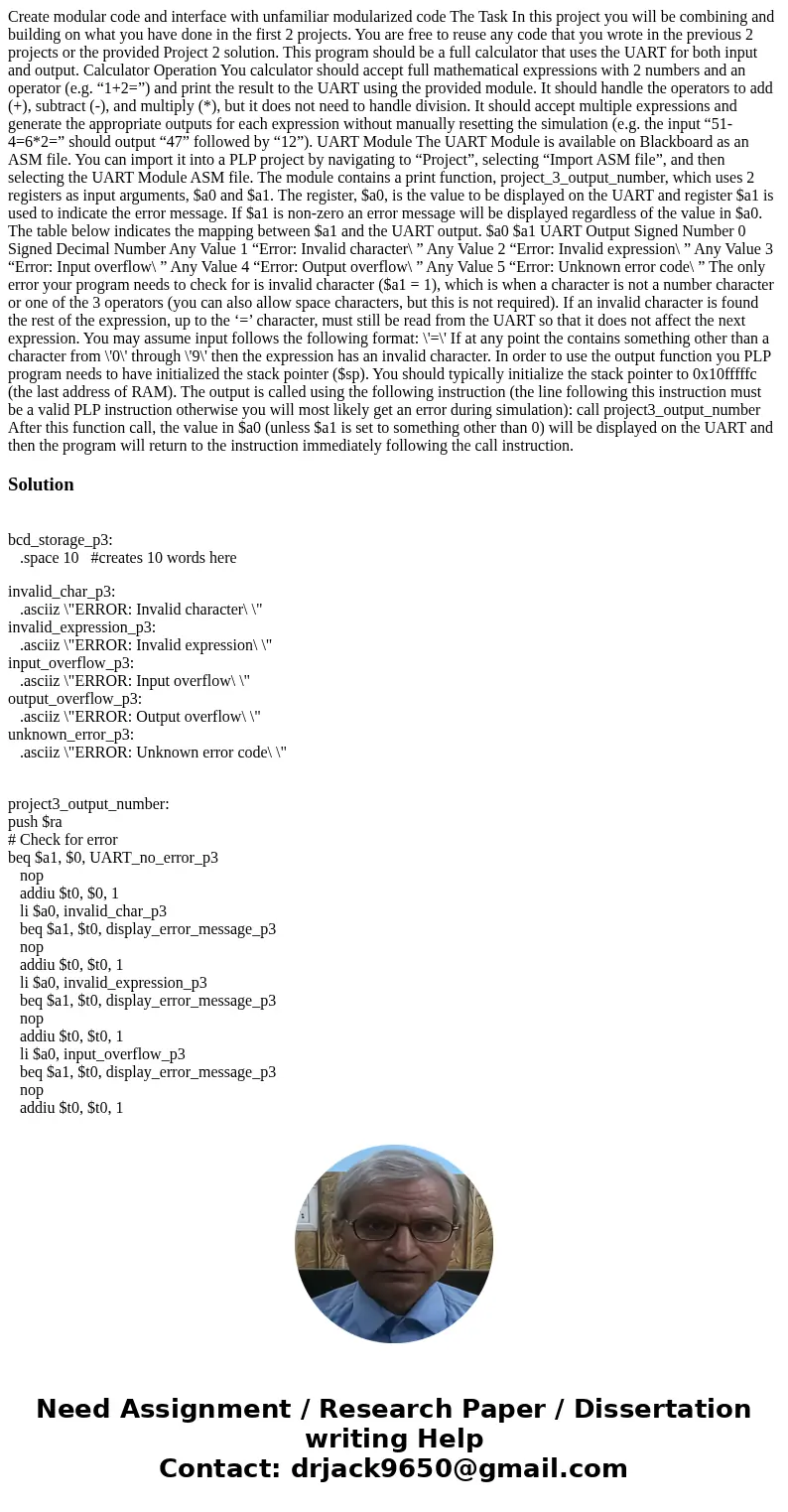
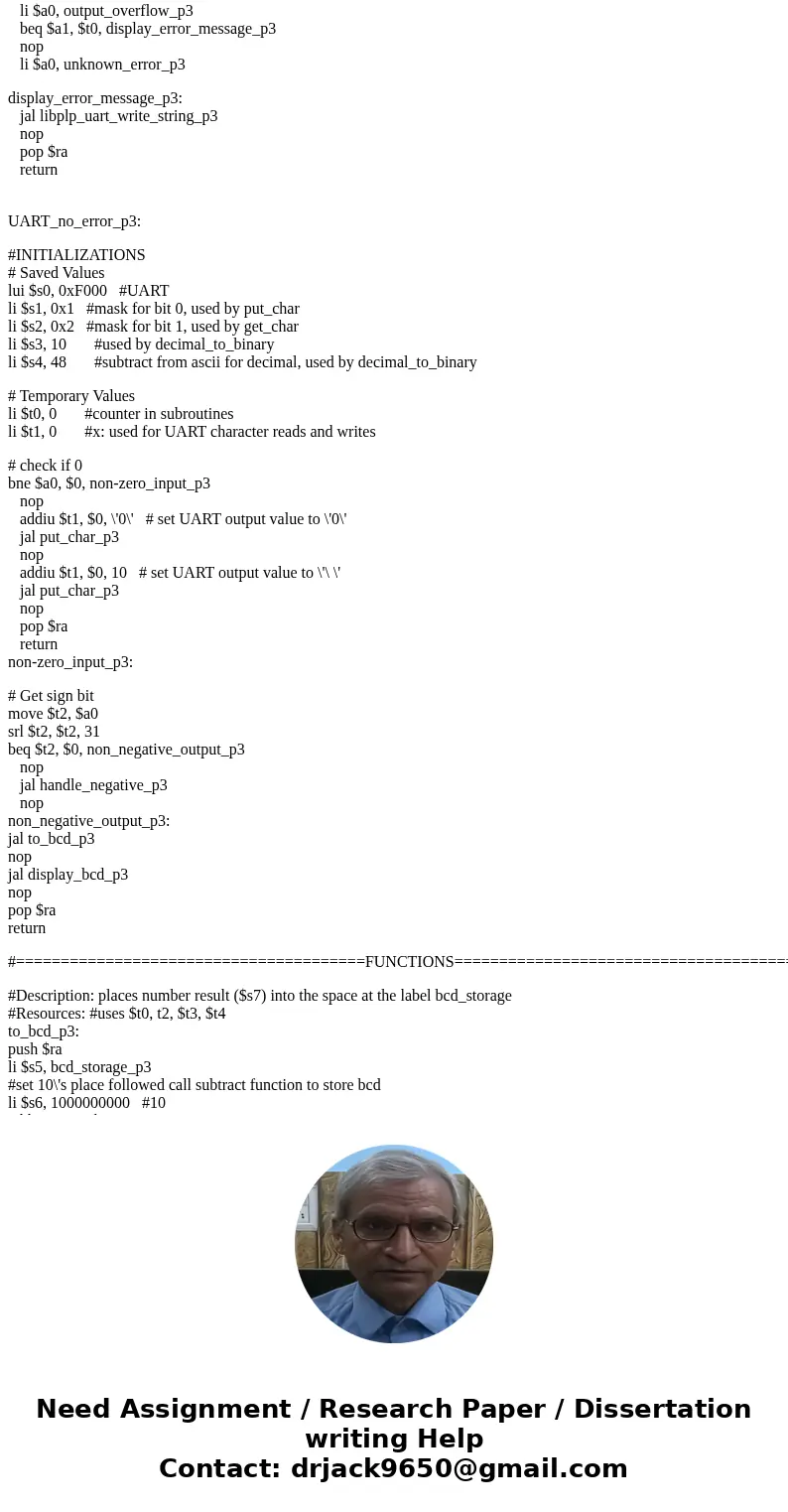
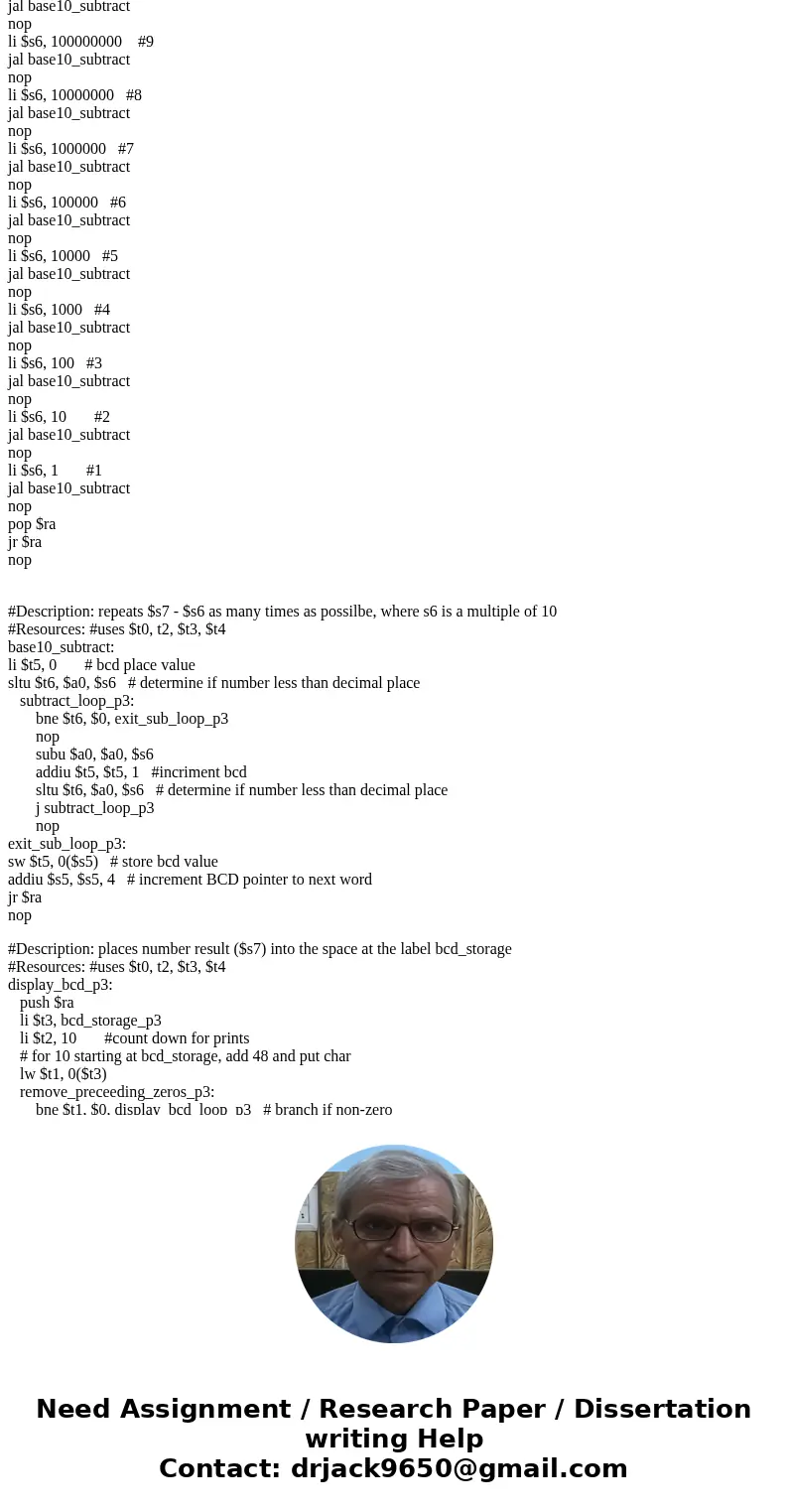
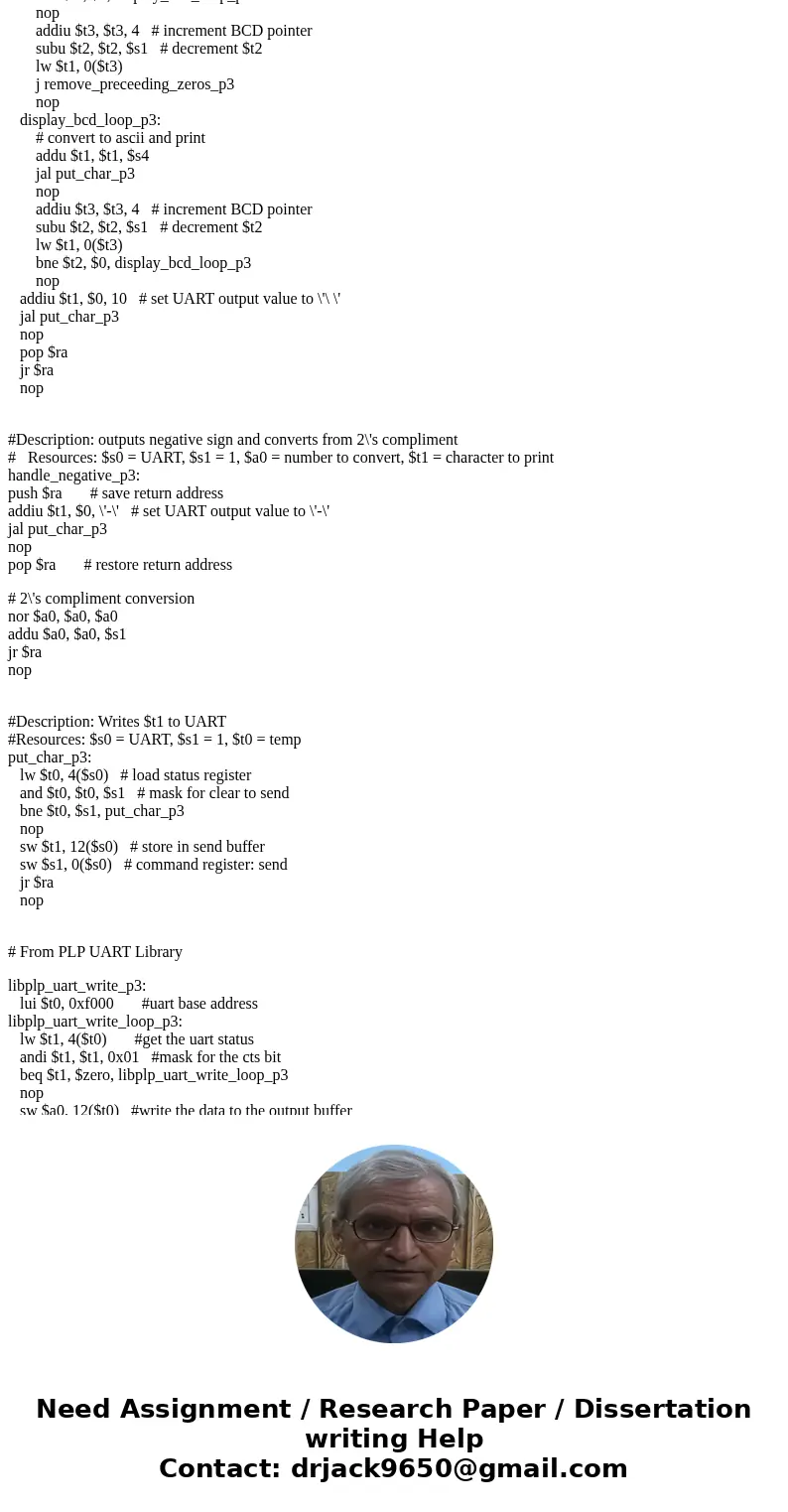
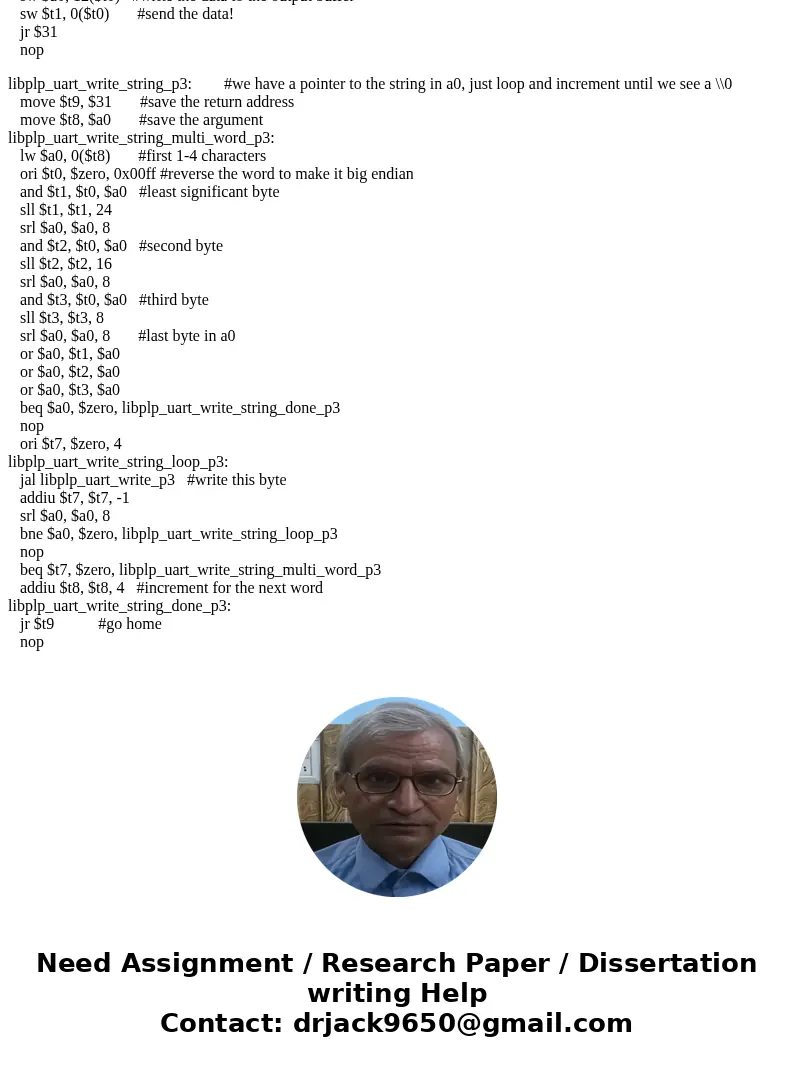
 Homework Sourse
Homework Sourse